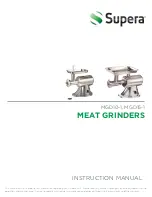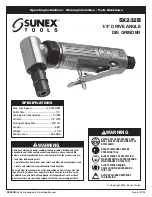
10
- Overload protection
- When the tool becomes overloaded, the indication
lamp lights up. When the load on the tool is reduced,
the lamp goes out.
- If the tool continues to be overloaded and the
indication lamp continues to light up for approximately
two seconds, the tool stops. This prevents the motor
and its related parts from being damaged.
- In this situation, move the slide switch to the “O (OFF)”
position once. And then move it to the “I (ON)” position
again to restart.
- Battery cartridge replacing signal
- When the remaining battery capacity is low, the
indicator lamp lights up during operation earlier than
that of high battery capacity.
- Accidental re-start preventive function
- Even if the battery cartridge is inserted on the tool with
the slide switch in the “I (ON)” position, the tool does
not start. In this situation, the lamp flickers slowly. It
indicates that the accidental re-start preventive
function is at work.
- To start the tool, first slide the slide switch toward the
“O (OFF)” position and then slide it toward the “I (ON)”
position.
Shaft lock (Fig. 4)
CAUTION:
• Never actuate the shaft lock when the spindle is
moving. The tool may be damaged.
Press the shaft lock to prevent spindle rotation when
installing or removing accessories.
Switch action (Fig. 5)
CAUTION:
• Before inserting the battery cartridge into the tool,
always check to see that the slide switch actuates
properly and returns to the “OFF” position when the
rear of the slide switch is depressed.
To start the tool, slide the slide switch toward the “I (ON)”
position. For continuous operation, press the front of the
slide switch to lock it.
To stop the tool, press the rear of the slide switch, then
slide it toward the “O (OFF)” position.
ASSEMBLY
CAUTION:
• Always be sure that the tool is switched off and the
battery cartridge is removed before carrying out any
work on the tool.
Installing side grip (handle) (Fig. 6)
CAUTION:
• Always be sure that the side grip is installed securely
before operation.
Screw the side grip securely on the position of the tool as
shown in the figure.
Installing or removing wheel guard (For
depressed center wheel, multi disc/
abrasive cut-off wheel, diamond wheel)
For tool with locking screw type wheel guard (Fig. 7)
WARNING:
• When using a depressed center grinding wheel/Multi-
disc, flex wheel, wire wheel brush, cut-off wheel or
diamond wheel, the wheel guard must be fitted on the
tool so that the closed side of the guard always points
toward the operator.
• When using an abrasive cut-off/diamond wheel, be
sure to use only the special wheel guard designed for
use with cut-off wheels. (In European countries, when
using a diamond wheel, the ordinary guard can be
used.)
Mount the wheel guard with the protrusion on the wheel
guard band aligned with the notch on the bearing box.
Then rotate the wheel guard to such an angle that it can
protect the operator according to work. Be sure to tighten
the screw securely.
To remove wheel guard, follow the installation procedure
in reverse.
Installing or removing depressed center
grinding wheel/Multi-disc (Fig. 8)
WARNING:
• Always use supplied guard when depressed center
grinding wheel/Multi-disc is on tool. Wheel can shatter
during use and guard helps to reduce chances of
personal injury.
Mount the inner flange onto the spindle. Fit the wheel/disc
on the inner flange and screw the lock nut onto the
spindle.
To tighten the lock nut, press the shaft lock firmly so that
the spindle cannot revolve, then use the lock nut wrench
and securely tighten clockwise.
(Fig. 9)
To remove the wheel, follow the installation procedure in
reverse.
WARNING:
• Only actuate the shaft lock when the spindle is not
moving.
OPERATION
WARNING:
• It should never be necessary to force the tool. The
weight of the tool applies adequate pressure. Forcing
and excessive pressure could cause dangerous wheel
breakage.
• ALWAYS replace wheel if tool is dropped while
grinding.
• NEVER bang or hit grinding disc or wheel onto work.
• Avoid bouncing and snagging the wheel, especially
when working corners, sharp edges etc. This can
cause loss of control and kickback.
• NEVER use tool with wood cutting blades and other
sawblades. Such blades when used on a grinder
frequently kick and cause loss of control leading to
personal injury.






































